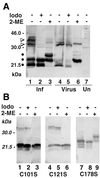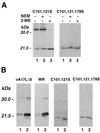Disulfide bonds and membrane topology of the vaccinia virus A17L envelope protein
- PMID: 10666276
- PMCID: PMC111727
- DOI: 10.1128/jvi.74.5.2438-2442.2000
Disulfide bonds and membrane topology of the vaccinia virus A17L envelope protein
Abstract
The envelope protein encoded by the vaccinia virus A17L open reading frame is essential for virion assembly. Our mutagenesis studies indicated that cysteines 101 and 121 form an intramolecular disulfide bond and that cysteine 178 forms an intermolecular disulfide linking two A17L molecules. This arrangement of disulfide bonds has important implications for the topology of the A17L protein and supports a two-transmembrane model in which cysteines 101 and 121 are intraluminal and cysteine 178 is cytoplasmic. The structure of the A17L protein, however, was not dependent on these disulfide bonds, as a recombinant vaccinia virus with all three cysteine codons mutated to serines retained infectivity.
Figures




References
MeSH terms
Substances
LinkOut - more resources
Full Text Sources

